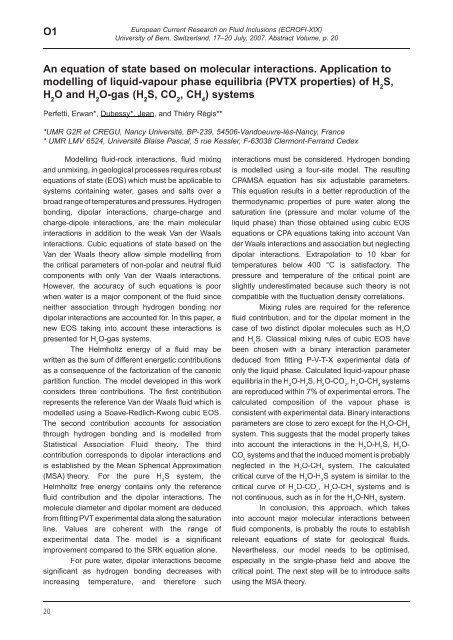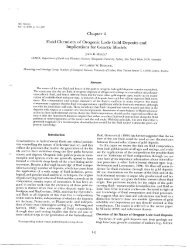Download Abstract Volume (pdf 7 MB) - Institut für Geologie
Download Abstract Volume (pdf 7 MB) - Institut für Geologie
Download Abstract Volume (pdf 7 MB) - Institut für Geologie
You also want an ePaper? Increase the reach of your titles
YUMPU automatically turns print PDFs into web optimized ePapers that Google loves.
O1European Current Research on Fluid Inclusions (ECROFI-XIX)University of Bern, Switzerland, 17–20 July, 2007. <strong>Abstract</strong> <strong>Volume</strong>, p. 20An equation of state based on molecular interactions. Application tomodelling of liquid-vapour phase equilibria (PVTX properties) of H 2S,H 2O and H 2O-gas (H 2S, CO 2, CH 4) systemsPerfetti, Erwan*, Dubessy*, Jean, and Thiéry Régis***UMR G2R et CREGU, Nancy Université, BP-239, 54506-Vandoeuvre-lès-Nancy, France* UMR LMV 6524, Université Blaise Pascal, 5 rue Kessler, F-63038 Clermont-Ferrand CedexModelling fluid-rock interactions, fluid mixingand unmixing, in geological processes requires robustequations of state (EOS) which must be applicable tosystems containing water, gases and salts over abroad range of temperatures and pressures. Hydrogenbonding, dipolar interactions, charge-charge andcharge-dipole interactions, are the main molecularinteractions in addition to the weak Van der Waalsinteractions. Cubic equations of state based on theVan der Waals theory allow simple modelling fromthe critical parameters of non-polar and neutral fluidcomponents with only Van der Waals interactions.However, the accuracy of such equations is poorwhen water is a major component of the fluid sinceneither association through hydrogen bonding nordipolar interactions are accounted for. In this paper, anew EOS taking into account these interactions ispresented for H 2O-gas systems.The Helmholtz energy of a fluid may bewritten as the sum of different energetic contributionsas a consequence of the factorization of the canonicpartition function. The model developed in this workconsiders three contributions. The first contributionrepresents the reference Van der Waals fluid which ismodelled using a Soave-Redlich-Kwong cubic EOS.The second contribution accounts for associationthrough hydrogen bonding and is modelled fromStatistical Association Fluid theory. The thirdcontribution corresponds to dipolar interactions andis established by the Mean Spherical Approximation(MSA) theory. For the pure H 2S system, theHelmholtz free energy contains only the referencefluid contribution and the dipolar interactions. Themolecule diameter and dipolar moment are deducedfrom fitting PVT experimental data along the saturationline. Values are coherent with the range ofexperimental data The model is a significantimprovement compared to the SRK equation alone.For pure water, dipolar interactions becomesignificant as hydrogen bonding decreases withincreasing temperature, and therefore suchinteractions must be considered. Hydrogen bondingis modelled using a four-site model. The resultingCPAMSA equation has six adjustable parameters.This equation results in a better reproduction of thethermodynamic properties of pure water along thesaturation line (pressure and molar volume of theliquid phase) than those obtained using cubic EOSequations or CPA equations taking into account Vander Waals interactions and association but neglectingdipolar interactions. Extrapolation to 10 kbar fortemperatures below 400 °C is satisfactory. Thepressure and temperature of the critical point areslightly underestimated because such theory is notcompatible with the fluctuation density correlations.Mixing rules are required for the referencefluid contribution, and for the dipolar moment in thecase of two distinct dipolar molecules such as H 2Oand H 2S. Classical mixing rules of cubic EOS havebeen chosen with a binary interaction parameterdeduced from fitting P-V-T-X experimental data ofonly the liquid phase. Calculated liquid-vapour phaseequilibria in the H 2O-H 2S, H 2O-CO 2, H 2O-CH 4systemsare reproduced within 7% of experimental errors. Thecalculated composition of the vapour phase isconsistent with experimental data. Binary interactionsparameters are close to zero except for the H 2O-CH 4system. This suggests that the model properly takesinto account the interactions in the H 2O-H 2S, H 2O-CO 2systems and that the induced moment is probablyneglected in the H 2O-CH 4system. The calculatedcritical curve of the H 2O-H 2S system is similar to thecritical curve of H 2O-CO 2, H 2O-CH 4systems and isnot continuous, such as in for the H 2O-NH 3system.In conclusion, this approach, which takesinto account major molecular interactions betweenfluid components, is probably the route to establishrelevant equations of state for geological fluids.Nevertheless, our model needs to be optimised,especially in the single-phase field and above thecritical point. The next step will be to introduce saltsusing the MSA theory.20





